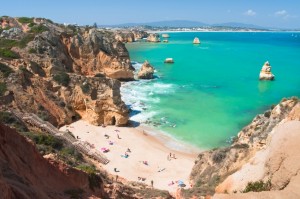2013 the “best year ever” for Portuguese tourism
Statistics for 2013 show healthy growth from external markets
Tourism contributes to a positive trade balance and job creation
Further growth limited by lacklustre domestic demand
Statistics published by the National Statistics Institute (INE) for tourist establishments in 2013 show that overnight stays by visitors from external markets grew by a robust 8% year-on-year, although those from within Portugal showed a slight reduction of 0.9%.
The increase in external visitors was particularly marked among those from France and the USA, and was in contrast to the fall in the numbers of domestic visitors, reflecting the general fall in domestic consumption brought about by successive euro crisis austerity budgets.
The rise in the numbers of French visitors can also be attributed to euro-related economic pressures, as tax increases in France, coupled with the low tax regime now on offer to those taking up “non-habitual residency”, have combined to stimulate growing interest in Portugal as a retirement destination.
Revenue was also up 5.4 percent on last year’s total, climbing above €1.9 billion.
Tourism contributes to positive trade balance and job creation
Speaking at a press conference, Portugal’s Economy Minister announced that 2013 was the best year ever for tourism, reinforcing “trust and hope” in the country’s ability to be fiscally autonomous.
The Minister Pires de Lima commented: “In 2013 tourism established itself as the sector that most contributed towards the positive outcome of our balance of trade. This balance came in at around 104.3 percent and was positive for the first time in decades”.
In Pires de Lima’s opinion the results are “historic” as they come at an economic moment that is “particularly demanding and very challenging.” He mentioned that, of the 128,300 jobs created between March and December 2013 in the Portuguese economy, about 20% were tourism-related.
Potential for further expansion
The demand for overnight stays from domestic visitors has fallen by a total of more than 10% in the past 3 years. Although still in decline, the rate of decline is now much smaller than in previous years, and, with the domestic market accounting for nearly 30% of total overnight stays, a wider recovery in the Portuguese economy would have a big positive effect on overall tourism numbers.
Visitors from Spain grew marginally year-on-year but showed a dramatic rise of 18.5% in December. This is evidence of Spanish consumer resilience in the face of ongoing high unemployment and falling property prices. Economic recovery in Spain would also be very positive for Portuguese tourism.
The Algarve moves ahead but underperforms Portugal as a whole
The number of Algarve guests in 2013 grew by 3.6% tear-on-year to 3.15 million, with a record-breaking €609 million generated in overall revenue. Faro International Airport saw some six million passengers pass through its doors, while the number of rounds of golf played on the region’s greens rose above one million for the first time since 2009.
When looking at the figures region by region, the Algarve, although by far the most popular region with 35.5% of overnight stays, underperformed relative to the average, with a total growth of 3.5% (av. 5.2%) made up of an increase of 5.5% (av. 8%) in non-residents, offset by a decline of 2.9% in residents (av. -0.9%).
Some of the factors driving overall growth – French interest in the country as a retirement destination, US economic growth feeding through to greater outbound tourism – have played to the strengths of regions other than the Algarve.
The Azores, Madeira, the North and Lisbon all performed better overall, with only the Central and Alentejo regions performing worse. In terms of growing popularity among non-residents, the Azores stood out with a year-on-year increase of 24.6%.




